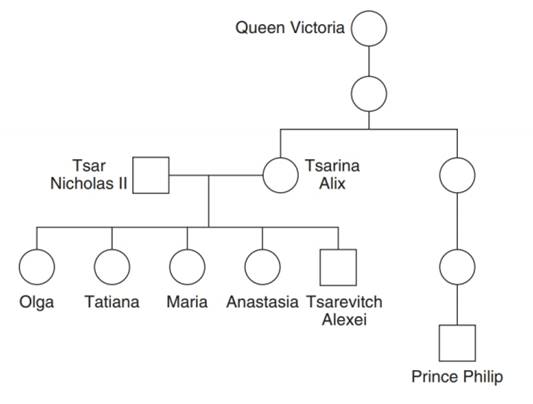
On July 17, 1918, Tsar Nicholas II; his wife the Tsarina Alix; their daughters Olga, Tatiana, Maria, and Anastasia; their son, the Tsarevitch (Crown Prince) Alexei; and four loyal retainers were murdered by Bolshevik revolutionaries. The bodies were not recovered for many years, fueling legends that Grand Duchess Anastasia had escaped, and allowing a woman named Anna Anderson to claim that she was Anastasia. In 1991 and in 2007, two mass graves with a total of nine skeletal remains were unearthed at Ekaterinburg in Russia’s Ural Mountains. The table that follows presents partial DNA fingerprint analysis (using only five SSR loci and the sex chromosome marker Amel) of these skeletons. Entries separated by commas indicate alleles (number of repeating units).
| a. | What is the most likely identification for each skeleton? (Note: You cannot differentiate among any of the daughters based on this information alone.)  |
| b. | Three PCR reactions failed to yield PCR products. If the reactions had worked properly, what alleles would you expect to see in each case? |
| c. | Are any of the daughters identical twins? |
| d. | What kind of evidence could you obtain from the skeletons to differentiate among the daughters? |
| e. | How do these DNA fingerprints repudiate the claims of Anna Anderson? The DNA fingerprint data in the table are certainly consistent with the idea that some of these skeletons were members of the Tsar’s family, but they do not prove the hypothesis. To investigate further,  |
| f. | For autosomal DNA markers, what percentage of alleles in the Tsarina’s skeleton should match with alleles in Prince Philip’s genome? |
| g. | For autosomal DNA markers, what percentage of alleles in the Tsarevitch’s skeleton should match with alleles in Prince Philip’s genome? |
| h. | A question for genealogy aficionados: What is Prince Philip’s relationship with the Tsarina? |
Want to see the full answer?
Check out a sample textbook solution
Chapter 10 Solutions
Genetics: From Genes to Genomes, 5th edition
- State the five functions of Globular Proteins, and give an example of a protein for each function.arrow_forwardDiagram of check cell under low power and high powerarrow_forwarda couple in which the father has the a blood type and the mother has the o blood type produce an offspring with the o blood type, how does this happen? how could two functionally O parents produce an offspring that has the a blood type?arrow_forward
- What is the opening indicated by the pointer? (leaf x.s.) stomate guard cell lenticel intercellular space none of thesearrow_forwardIdentify the indicated tissue? (stem x.s.) parenchyma collenchyma sclerenchyma ○ xylem ○ phloem none of thesearrow_forwardWhere did this structure originate from? (Salix branch root) epidermis cortex endodermis pericycle vascular cylinderarrow_forward
- Identify the indicated tissue. (Tilia stem x.s.) parenchyma collenchyma sclerenchyma xylem phloem none of thesearrow_forwardIdentify the indicated structure. (Cucurbita stem l.s.) pit lenticel stomate tendril none of thesearrow_forwardIdentify the specific cell? (Zebrina leaf peel) vessel element sieve element companion cell tracheid guard cell subsidiary cell none of thesearrow_forward
- What type of cells flank the opening on either side? (leaf x.s.) vessel elements sieve elements companion cells tracheids guard cells none of thesearrow_forwardWhat specific cell is indicated. (Cucurbita stem I.s.) vessel element sieve element O companion cell tracheid guard cell none of thesearrow_forwardWhat specific cell is indicated? (Aristolochia stem x.s.) vessel element sieve element ○ companion cell O O O O O tracheid O guard cell none of thesearrow_forward
- Essentials Health Info Management Principles/Prac...Health & NutritionISBN:9780357191651Author:BowiePublisher:Cengage
 Principles Of Radiographic Imaging: An Art And A ...Health & NutritionISBN:9781337711067Author:Richard R. Carlton, Arlene M. Adler, Vesna BalacPublisher:Cengage LearningSurgical Tech For Surgical Tech Pos CareHealth & NutritionISBN:9781337648868Author:AssociationPublisher:Cengage
Principles Of Radiographic Imaging: An Art And A ...Health & NutritionISBN:9781337711067Author:Richard R. Carlton, Arlene M. Adler, Vesna BalacPublisher:Cengage LearningSurgical Tech For Surgical Tech Pos CareHealth & NutritionISBN:9781337648868Author:AssociationPublisher:Cengage





